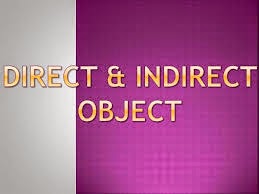ACTION PART (TENSES)
PASSIVE VOICE
1. Simple works (Present) -----> am / is / are + M.V 3rd form /
13 modal auxiliaries + M.V 3rd form.
2. Completed Works -----> was / were M.V. 3rd form /
has / have / had + been + M.V. 3rd form.
3. Continuous Works ----> Be forms + being + M.V. Ing form.
In-fact when we want to apply the above rule of Passive Voice at first we must identify the "Object" whether it is there in a sentence based on "Subject" rule or not. If it is identified it can be applied with Passive rule.
IDENTIFICATION OF OBJECT
Mainly there are two kinds of Object. They are "Direct Object" and Indirect Object".
Direct Object: It is the form of thing, place etc., except person. To identify that we have to question the "Verb" in a sentence with the questioning word "What". Then the answer we get is called Direct Object.
Ex: I write a Novel. (What)
He got a prize. (What)
She is dreaming a picture.
INDIRECT OBJECT: It is in the form of person. This person is the benefactor of an action. To identity this 'indirect object' we have to question the verb in a sentence with the questioning words like "Whom" or "To whom". Then the answer we get is called "Indirect Object".
Ex: He disappointed me. (Whom)
Police is interrogated the thief. (Whom)
The doctor treats the patient.
NOTE: When we see the above examples in the first sentences we identified Direct Object, in the second sentence we Identified Indirect Object. But in some sentences we can identify both direct and indirect objects also, and in some sentences we can identify no object.
That means there is no rule that every sentence must contain object. It may be or may not be even it starts with Subject.
But the sentence which contains 'object' is said that it is in Active Voice.
The Main Verb which follows the Object is called Transitive Verb.
These Transitive Verbs are the basement for the application of Passive Voice.
After coming to know about the Object and Passive Voice. Here onwards we can observe each and every view, how it is said with Subject rule and Object rule. (Active and Passive)
Continue to ...... Part - 3


